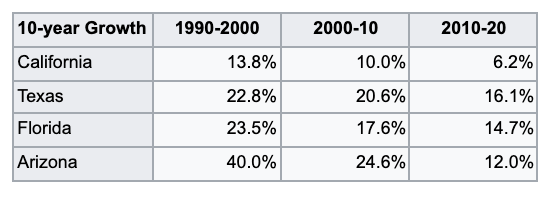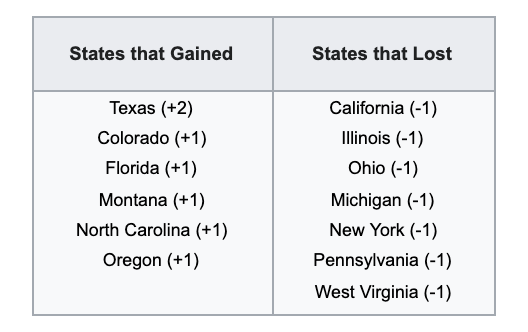Update 525 — The Decelerated Decennial:
Demographic Stasis in Census a Surprise
The U.S. Census Bureau released the official state results of the 2020 Census on Monday, after a series of legal changes, budget battles, and deadline extensions. The decennial count showed that the U.S. population grew by 22.7 million, just 7.4 percent in the last decade. Not only was this the slowest population growth since the 1930s and the second slowest gain ever, but it yielded the smallest number of Congressional seat reallocations in over a century.
These results are only the topline numbers, with more detailed data — on which Congressional redistricting will be based — available in September. But these preliminary 2020 Census results reveal key demographic and political trends. We explore these revelations and the political and economic policy implications below.
Best,
Dana
—————–
2020 Count Compared to Past Results
The 2020 Census was politically contentious and difficult to administer, perhaps the most in living memory. Due to the logistical difficulties caused by the COVID-19 pandemic, it is running around five months behind schedule, but thanks to the tireless efforts of Census enumerators who put their lives at risk to ensure an accurate count, the numbers are in.
Each decennial census, congressional seats are reallocated through a “priority value” formula that takes into account population changes over the last decade. While all but three states gained population since 2010, states in the South and West grew faster than those in the North and Midwest, continuing a half century long trend.
However, the census results also showed that the robust growth much of the South and West experienced during the 90s and 00s seems to be finally slowing down. Texas, Florida, and Arizona all underperformed initial estimates, and California lost a congressional seat for the first time in its history.

Rhode Island and Minnesota were expected to lose a seat but avoided the chopping block this cycle. New York, which has lost at least two congressional districts for the past seven census cycles, lost only one in 2020 and came within 89 people of keeping all of their seats. The Rust Belt states suffered the worst growth rates of any region, losing four seats collectively, yet another indication of the economic hollowing out of America’s industrial base.
Electoral Ramifications
In 2020, Joe Biden received 306 electoral votes to Donald Trump’s 232. Assuming every state were to vote the same way in 2024, under the census’s new congressional reallocation, the electoral college breakdown would be 303 to 235, a three-seat swing in the Republican’s favor. This is a smaller electoral shift than in 2010 or 2000 when Republicans netted 6 and 7 electoral votes respectively from congressional reallocation.
More important than the electoral college is how this 2020 Census affects congressional maps for the next decade. This year, six states gained seats while seven lost seats.

While we won’t have precise demographic data necessary for redistricting until August, Republicans will fully control the line-drawing process for 187 of 435 seats while Democrats will only control 75 seats, with another 167 districts being drawn by independent commissions or divided state governments. The six remaining congressional districts are at-large, meaning lines will not need to be drawn. These new census numbers underscore the need for Congress to pass the For the People Act (H.R. 1) to prevent partisan gerrymandering. H.R. 1 would require states to establish nonpartisan redistricting commissions to redraw their congressional districts every 10 years rather than state legislatures, ensuring a fair and democratic process in the future.
Geography and Voting Patterns
The census may have important consequences for control of the House. Of the six states that gained seats, four are Republican-leaning, while six of the seven states that lost seats are Democratic-leaning. Democrats currently have a narrow six-member margin, meaning Republicans need to flip only a handful of seats to regain control of the House.
Migration within the United States was a driving force behind the recent census results, with a growing number of blue-state inhabitants moving West or South to mostly red-states. California will lose a congressional seat for the first time due to slowing migration to the state and significant out-migration. On the other hand, Texas has become a popular destination for domestic migrants and immigrants over the last decade and will gain two House seats as a result of its rapidly growing population.
Although the full extent of these demographic changes will not be known until later this year, political commentators have long speculated on the political impact of blue-state migration to Republican-leaning states. News outlets have suggested that this blue-state diaspora will reshape politics in red-leaning states, but analysis from Nate Silver and Harry Enten shows that movers are more likely to share the political opinions of their new home than their old. That is, liberal movers are attracted to liberal states and conservative movers to conservative states. In the box below, we examine a migration out of California to red-states like Texas.
| Domestic Migration: Leaving California California has experienced a net migration loss for the second year in a row, with more than 135,000 people leaving the state than moving there in 2020. The most popular destination for Californians has been Texas. Approximately 81,000 Californians moved to Texas this past year, sparking concern among Texans that Golden State transplants will bring left-wing politics to their new home. According to a 2019 Berkeley poll, this trend is likely to continue, with 52 percent of Californians considering leaving the state. However, the Berkeley IGS poll found that among the reasons Californians are considering leaving, 71 percent of those surveyed cited the cost of housing, 58 percent cited high taxes, and 47 percent mentioned the state’s political culture. The poll also found that the political beliefs of those considering leaving California skewed conservative, meaning that those leaving the blue-state of California are more likely to be conservative. Thus, blue-state migrants may have a less pronounced political impact on conservative states than expected. |
Long-term Outlook
According to U.S. Census data, population growth has slowed in the past 10 years to the lowest rate since the Great Depression. But unlike the 1930s, this slowdown is indicative of a longer-term trend and not a dip before a dramatic rebound. The current slowdown is rooted in an aging white population and decreased life expectancy coupled with low birth rates and lagging immigration. Given the remote likelihood of domestic demographic trends improving, robust immigration will be necessary to prevent economic and demographic growth from stagnating over the next 50 years.
Although population growth is slowing, adequate representation in Congress is another concern, given the census results. Congress currently has the worst population-to-representative ratio of any industrial democracy, but this wasn’t always the case. For most of America’s history, Congress increased the number of House seats with each new census, but this practice was halted in 1913.
A member of the House today serves around 760,000 constituents while a member a century ago only had 212,000; in 1790, this number was about 32,000. One proposal to remedy this imbalance marginally known as the “Wyoming Rule” would increase the number of congressional seats so that no single district is larger than the smallest state’s population. Under this formula, the number of Representatives would increase to 573, making every congressional district’s population more equal.

viagra
kamagra emea
after effects of viagra
cialis prices
clomiphene
antabuse over the counter generic
comparison viagra cialis
buy isotretinoin acnetrex
cialis no prescription
buy cialis uk
Fantastic post but I was wanting to know if you could write a litte more on this subject?
I’d be very thankful if you could elaborate a little bit more.
Appreciate it!
drakengard nier art book Film Titeuf 1fichier Dvdrip Gratuitement la alberca history book
Hd Streaming Film Jackpot Convention Collective Casino Distribution Pour Les Vacances Pharmacie Geant Casino Brezet
GГ©ant Casino Fenouillet Mode De RГЁglement Casino Port Barcar S Annee Construction Casino Amneville
cialis 5mg online
cialis coupon
free local singles
totally free dating sites
Pingback: keto birthday cake
viagra canada pay pal viagra ice cream – viagra information
gay veterans dating
top 10 gay dating site
gay senior dating las vegas
denton viagra mom son viagra ViagraCND100Mg – viagra uses
old gay bear dating
only dating gay
the best free gay dating sites
gay not dating trans men
most successful gay dating site
hogwarts a mystery dating gay